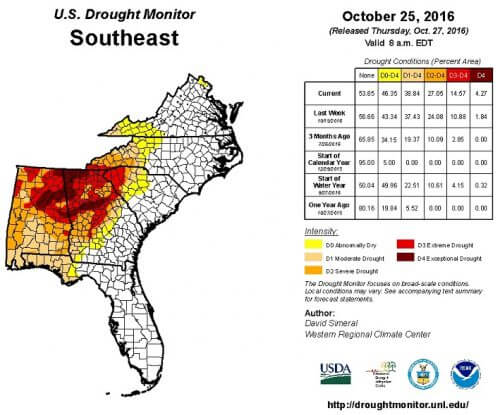Southeastern Drought Highlights the Need for Flow Protection Policy
Across the southeast, river protection groups and clean water advocates are raising the alarm as extreme drought conditions continue to spread following several months of below normal rainfall and hotter than normal temperatures. Photographs show waterfalls with no falling water, shoals with no tumbling water, only dry riverbed and rock, and stranded and dying rare and endangered mussels along with other fish, snails and mussels without enough clean water. 
Not only are waterways, fish and wildlife being severely impacted, communities like Haralson County, GA and Van Buren County, TN are facing the possibility of running out of drinking water, and farmers’ crops and livestock operations are being damaged.
Organizations on the ground, like Alabama Rivers Alliance, are making sure elected officials – and the public – are aware of the drought’s impact on our waterways and they are calling on decision makers to do more to better manage the state’s water resources.
As detailed in our new report “Protecting and Restoring Flows in Southeastern Rivers,” all of the southeastern states we evaluated could do more to better prepare for droughts and all of the states’ drought management policies could be improved. Georgia and North Carolina had the most robust drought plans, and Georgia has specific requirements in response to drought. While Georgia’s conservation prescriptions are clearly laid out and apply across the board, drought determinations are left to the discretion of the Georgia Environmental Protection Division. Alabama and Tennessee have plans that emphasize coordination but do not prescribe any actions for local governments or water systems to take at different levels of drought. South Carolina’s is similar, although it does allow a path for state-mandated action when critically needed. North Carolina allows water systems to set their own trigger and response levels but includes default conservation responses for communities without drought plans.
The “Protecting and Restoring Flows in Southeastern Rivers” report lays out key actions all southeastern states should take to better prepare for – and protect – our waterways and communities during times of drought:
- First, adopt policies that require water conservation and efficiency all the time, even when not in a drought, because it’s the best way to be prepared when there is a drought
- Second, adopt policies that are specifically enacted during times of drought and:
- Apply widely and provide specific details about water conservation actions that must happen at the local level during drought
- Account for conserving necessary river flows to support environmental functions and prevent water quality impairment
- Go into effect before impairments to environmental flows and water quality occur




